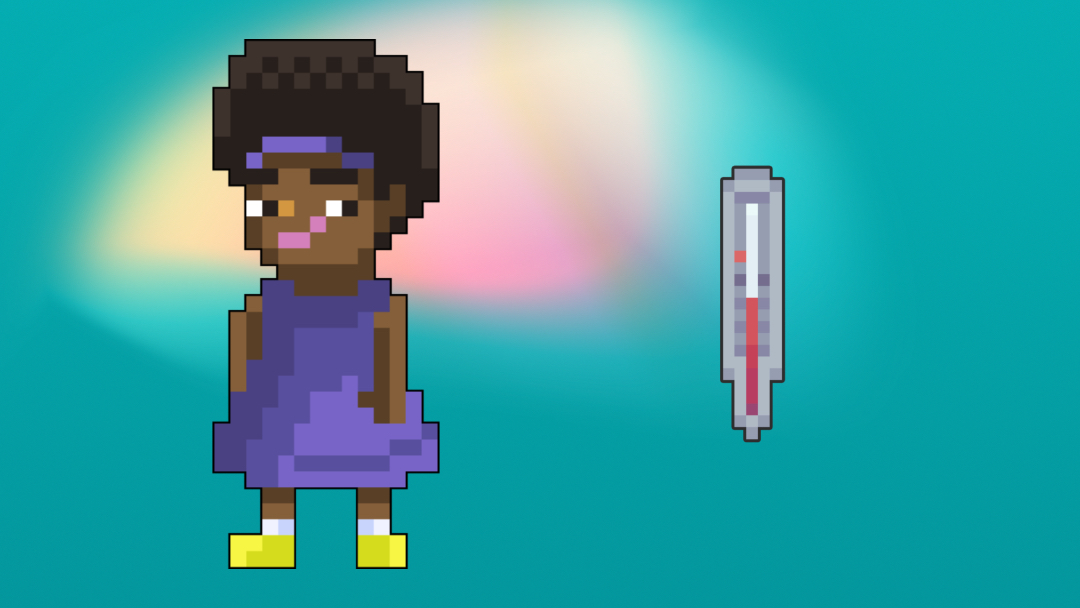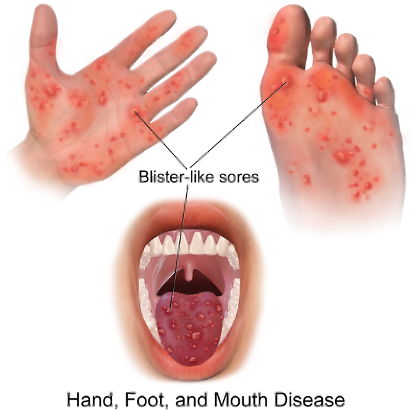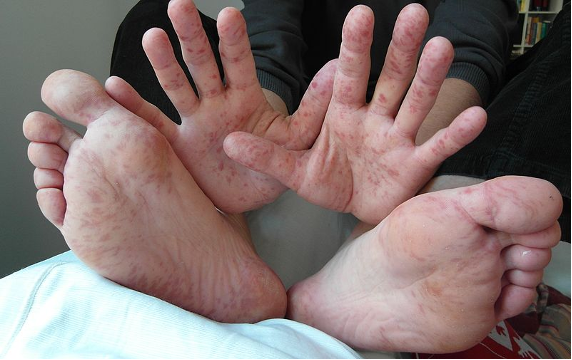- 📖 Geeky Medics OSCE Book
- ⚡ Geeky Medics Bundles
- ✨ 1300+ OSCE Stations
- ✅ OSCE Checklist PDF Booklet
- 🧠 UKMLA AKT Question Bank
- 💊 PSA Question Bank
- 💉 Clinical Skills App
- 🗂️ Flashcard Collections | OSCE, Medicine, Surgery, Anatomy
- 💬 SCA Cases for MRCGP
To be the first to know about our latest videos subscribe to our YouTube channel 🙌
Introduction
Hand, foot and mouth disease (HFMD) is a common self-limiting viral illness in children.1 It is usually caused by coxsackie or enterovirus and generally has good clinical outcomes.2,3
Aetiology
The two most common causative organisms of HFMD are coxsackie A virus (CA16) and enterovirus (EV71).1,4
HFMD is commonly transmitted through the faecal-oral route. However, it can also be transmitted via oral-oral and respiratory droplet contact.2,4
Risk factors
The most significant risk factor is contact with an infected person. The most at-risk groups are children under the age of 10 (especially under the age of four) and families/carers of children in this age group. This is because outbreaks usually spread within pre-schools, schools and households.3
Poor hygiene, especially whilst toileting, is another risk factor to consider.2
Clinical features
History
Typical symptoms of HFMD include:1,2,3
- A prodrome of low-grade fever, malaise, loss of appetite for 1-2 days prior to lesions appearing
- A non-pruritic rash that starts as a red macule and then develops into a grey vesicle affecting the oral mucosa, hands and feet (including palms and soles)
Other important areas to cover in the history include:1,3
- Age: usually affects children under 10 years old, with a predilection for those under four years
- Attendance at a daycare or school
- Contact with known infectious persons: either as a classmate or carer
- Pregnancy: HFMD in the last trimester can have considerable risks to the newborn
Clinical examination
Typical clinical findings in HFMD include:4
- Low-grade fever
- Rash affecting the mucous membranes of the mouth, palms and soles primarily, with extension to the trunk, buttocks and genitals in some cases (Figures 1 and 2)
Other important examination steps include:
- A general assessment of hydration status: dehydration can be a complication of HFMD due to reduced oral intake
- Neurological exam, with an assessment of neck stiffness: meningitis is a rare complication of HFMD
Differential diagnoses
It is important to differentiate HFMD from other rashes of childhood (Table 1).
Table 1. Causes of rashes in childhood and differentiating from HFMD.3,4
| Condition | Clinical features differentiating from HFMD |
| Atopic dermatitis | Tends to be a chronic condition without any prodromal features of HFMD. Additionally, affects flexures in children in the high-risk age group, as opposed to palms, soles and mouth |
|
Behcet syndrome |
Would tend to have additional arthralgia, with vascular and neurologic lesions. Persistent greater than the 7-10 days of HFMD and would require further investigation |
| Bullous impetigo | Caused by Staphylococcus aureus; lesions present as bullae that rupture then dry and scale, which primarily affect the trunk as opposed to the hands and feet |
| Erythema multiforme | Often secondary to infection with herpes simplex virus or Mycoplasma pneumoniae; lesions appear as two concentric rings with a dusky central zone that primarily affects the trunk, limbs and face |
| Herpangina | Caused by the Coxsackie virus with lesions solely affecting the oral cavity |
| Herpes (simplex or zoster) | Associated fever, pruritic lesions, and often distributed either in the oral or genital cavity. Herpetic gingivostomatitis can also mimic the stomatitis of HFMD. If herpes is suspected, it is important to confirm via pathology and consider involving local child protection services if there is a suspicion of abuse |
| Measles | Associated fever, cough and coryza, with Koplik spots (white spots in buccal mucosa) often present. The maculopapular rash of measles starts on the head and spreads distally |
| Pemphigus vulgaris | A potentially life-threatening differential that presents as bullae and erosions of the lips, tongue, buccal mucosae and oro-pharynx |
| Stevens-Johnson syndrome | Delayed drug reaction with concurrent fever |
| Varicella | Appears as a generalised pruritic rash starting on the face and trunk and spreading to the rest of the body |
Investigations
Generally, there are no investigations required for HFMD as it is a clinical diagnosis. A PCR of a throat, vesicle or rectal swab can be used to subtype the causative organism, but this is not routinely performed.2,3
Diagnosis
The diagnosis of HFMD is clinical, based on history, clinical examination and risk factors.
Management
HFMD requires supportive management.1,2,3,4 This includes good hydration, a soft diet and simple analgesia (paracetamol/ibuprofen). It is important to reassure the parents, provide education about the condition, and review the child in 48 hours.
It is important to maintain good hand hygiene practices.1,2 This is very important in children who still use nappies or are not toilet trained, as viral particles can persist in faecal matter for up to six weeks after infection.
There is no evidence that topical analgesics such as lidocaine are beneficial.2
HFMD is not a reportable or notifiable disease. There are no exclusion criteria for children although it is important to note that patients are infective until blisters have resolved.2,3
Complications
HFMD has an excellent prognosis with self-resolution after 7-10 days in the majority of cases.1,4
A common complication is superinfection with skin flora, most commonly Staphylococcus aureus, which may require antibiotic therapy.2
Another potential complication is dehydration due to the painful oral ulcers or stomatitis reducing oral intake.2, 4
Rarer complications include meningitis and cardiorespiratory failure.4
HFMD in pregnancy
Another important consideration is the maternal contraction of HFMD in the third trimester. Foetal infection increases the risk of meningoencephalitis, thrombocytopenia, disseminated intravascular coagulopathy, cardiomyopathy and hepatitis in the newborn.4
Key points
- HFMD is a common, self-limiting viral illness of childhood that requires supportive management.
- The most common causative organisms of HFMD are coxsackie A virus (CA16) and enterovirus (EV71).
- A history of age less than 10 years old, a known sick contact, a prodrome of 1-2 days in conjunction with a rash that affects the mucous membranes of the mouth, and the skin of palms and soles is highly suggestive of HFMD.
- Diagnosis is clinical and no investigations are routinely required.
- Supportive management is the mainstay of treatment. Reassure the parents and review the child at 48 hours.
- Common complications include superinfections with skin flora and dehydration.
- Maternal HFMD can result in serious complications in the neonate.
Reviewer
Dr Keith Hamd MBBS, FRACGP, DCH
General Practitioner
Editor
Dr Chris Jefferies
References
- Frydenberg and Starr. Hand, foot and mouth disease. 2003. Available from: [LINK]
- John Murtagh’s General Practice, 8e. Chapter 86: Common childhood infectious diseases (including skin eruptions). 2022. Available from: [LINK]
- Tidy et al. Hand, Foot and Mouth Disease. 2021. Available from: [LINK]
- Saguil et al. Hand-Foot-and-Mouth Disease: Rapid Evidence Review. 2019. Available from: [LINK]
- BruceBlaus. Hand Foot and Mouth Disease. Licence: [CC BY-SA 4.0]
- KlatschmohnAcker. Hand Foor and Mouth Disease Adult 36yrs. Licence: [CC BY-SA 3.0]






